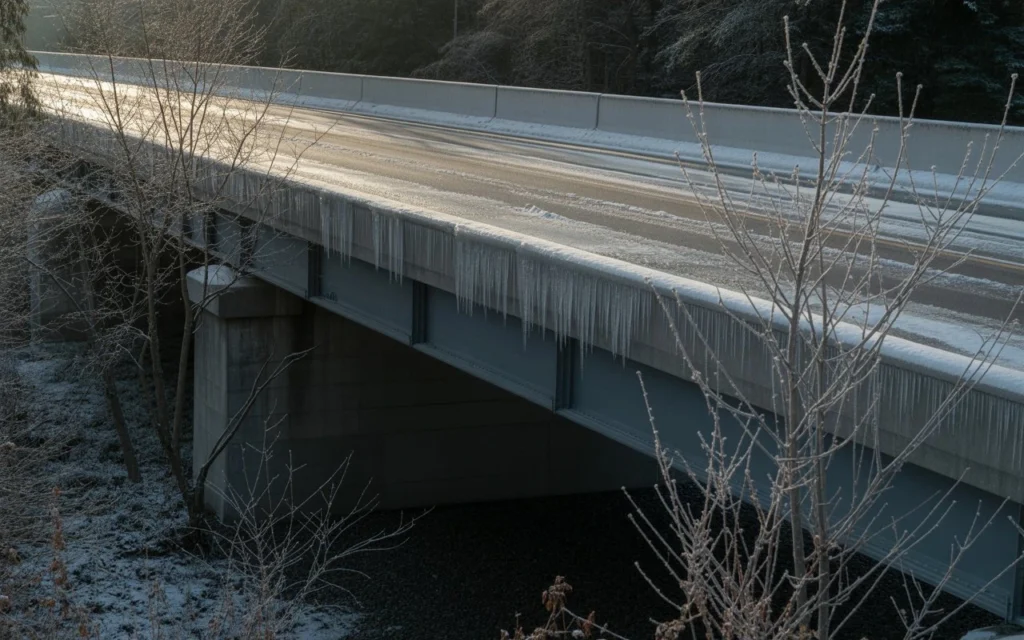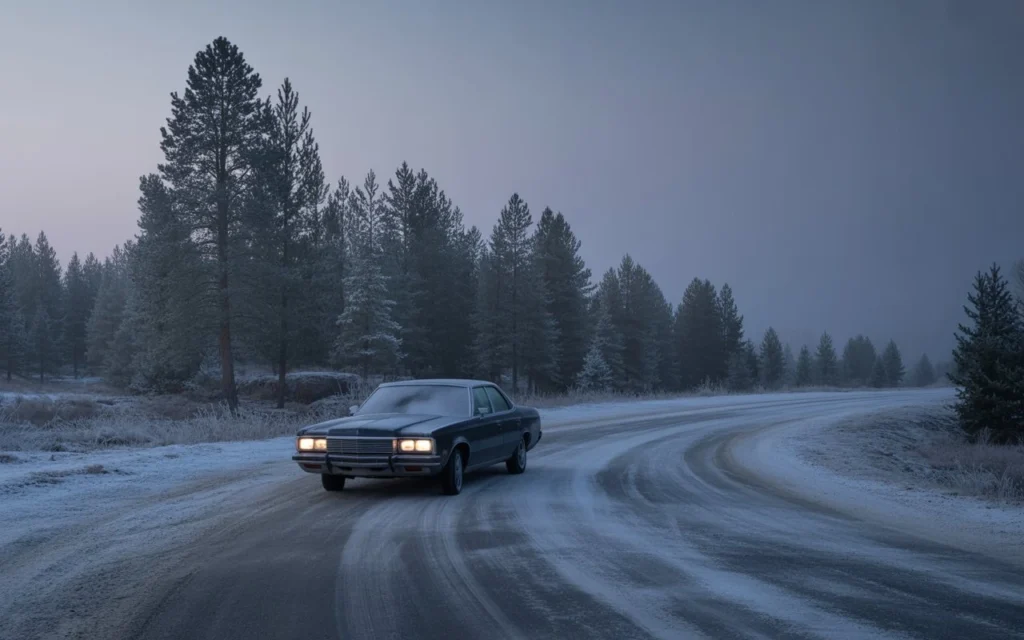Winter weather brings many hazards, but one of the most dangerous and deceptive is black ice. This thin, transparent layer of ice forms on roads, often blending in with the surface, making it nearly invisible to drivers. As the winter months settle in, knowing how to spot black ice and how to navigate it safely becomes essential for every driver.
In this article, we’ll explore what black ice is, where it’s commonly found, and provide you with safety tips to help you avoid black ice and stay safe while driving.
What is Black Ice?
Black ice refers to a thin layer of ice on the road that is nearly invisible. It forms when water freezes on the pavement and becomes difficult to detect, especially when roads are wet and temperatures hover just around freezing. The name “black ice” doesn’t refer to the color of the ice itself but rather the fact that it often forms on dark asphalt roads, making it blend into the road surface, often appearing as if the road is merely wet.
Black ice is often found on:
- Bridges and overpasses: These areas freeze more quickly because they are exposed to the cold air above and below.
- Shady areas: Locations where sunlight doesn’t reach the road surface, allowing ice to remain longer.
- Intersections: Areas where vehicles frequently stop, and the moisture from braking can freeze on the road.
- Roads near bodies of water: Such as rivers, lakes, or ponds, where moisture in the air can freeze onto the road.
Understanding where black ice is more likely to form can help you stay alert while driving during the winter months.
Where is Black Ice Most Commonly Found?
Black ice is most commonly found in the following areas, and being aware of them is key to avoiding accidents:

1. Bridges and Overpasses
Since bridges and overpasses have cold air circulating on both the top and underneath, they freeze faster than regular roadways. As a result, black ice forms much more quickly on these structures. Always approach bridges and overpasses slowly and carefully, especially during early mornings or late evenings when the temperature is at its lowest.
2. Shaded Areas
As black ice forms in cooler conditions, shaded areas on the road are often the first to be affected. The lack of sunlight prevents these areas from warming up, causing ice to remain on the road for longer periods. Watch for shaded stretches of road, particularly in forests or along mountainous routes.
3. Intersections
At intersections, cars often stop and start, which increases the chances of moisture from rain or melting snow freezing on the road. Black ice can form suddenly in these areas, especially if the temperatures have dropped after a rainstorm. Approach intersections cautiously, especially when the road appears wet.
4. Roads Near Water
If you’re driving near rivers, lakes, or ponds, be cautious. Black ice often forms in these areas because the moist air from the water can freeze when temperatures drop. Roads close to water are more likely to experience patches of black ice, particularly during cold nights and early mornings.
Safety Tips for Driving on Black Ice
Navigating black ice can be difficult, but with the right knowledge and precautions, you can reduce the risk of accidents. Here are some key safety tips to help you stay safe:
1. Reduce Speed and Increase Following Distance
The most important tip when driving in icy conditions is to slow down. Black ice makes roads slippery, and driving too fast can cause you to lose control of your vehicle. Slow down and increase your following distance to allow plenty of space between you and the car in front of you. This gives you more time to react if the car ahead suddenly brakes or loses control.
2. Avoid Sudden Movements
When driving on black ice, avoid sudden steering, acceleration, or braking. Smooth and gradual movements will help you maintain control of the vehicle. If you do start to skid, steer in the direction you want to go without jerking the wheel. This will help the vehicle regain traction and prevent you from spinning out.
3. Know How to Brake on Ice
If you need to brake on black ice, use gentle pressure on the brake pedal. If your car has anti-lock brakes (ABS), apply steady pressure to the brake pedal, and the system will automatically pump the brakes to prevent skidding. If you don’t have ABS, pump the brakes gently to avoid locking them up.
4. Stay Informed About Weather Conditions
Before heading out, always check the weather forecast and road conditions. Winter storms, rain, or thawing and refreezing temperatures can create conditions ideal for black ice. Stay informed so you can plan your travel around the worst weather.
5. Keep Your Windows Clear
Ensure that your windows and mirrors are clear before driving in winter conditions. Black ice often forms when temperatures dip, and visibility is crucial when driving on potentially slippery roads. Clear your windshield and side mirrors of snow, frost, and ice to ensure you have the best possible view of the road ahead.
What to Do If You Hit Black Ice
If you find yourself on black ice, it’s important to stay calm and maintain control of your vehicle. Here’s what to do:
- Do not panic. Avoid sudden jerks of the steering wheel or hard braking.
- Steer gently in the direction you want to go and keep the wheel steady.
- If you start to slide, remove your foot from the accelerator but do not brake suddenly.
- If the rear of your car starts to slide, gently steer into the skid to regain control.
What is black ice, and why is it dangerous?
Black ice is a thin, transparent layer of ice that forms on the road, making it almost invisible to drivers. It gets its name from its ability to blend in with the dark asphalt, often making it hard to detect. Black ice is especially dangerous because drivers don’t see it coming, which makes it easy to lose control of the vehicle. It is most commonly found in shaded areas, bridges, and overpasses where temperatures can drop suddenly.
How can I tell if I’m driving on black ice?
It can be difficult to spot black ice, as it often blends seamlessly with the road surface. However, there are a few signs to watch out for:
- Wet or shiny patches on the road, especially in shaded areas or bridge decks.
- Sudden loss of traction or slipping while driving, especially when you start to lose control of the vehicle.
- Weather conditions: Black ice is more likely when temperatures hover just below freezing, especially after a rainstorm or thaw.
What should I do if I hit black ice while driving?
If you find yourself on black ice, it’s important to stay calm and avoid sudden reactions. Here’s what you should do:
- Don’t panic – Keep a firm grip on the steering wheel.
- Steer gently in the direction you want to go and avoid sudden jerks.
- Take your foot off the accelerator, but do not brake suddenly.
- If your vehicle begins to skid, steer into the skid to regain control.
Remember, smooth movements are key to maintaining control of your vehicle on black ice.
How can I prevent accidents caused by black ice?
Preventing accidents caused by black ice involves preparation and caution. Here are some tips:
- Slow down when driving in cold weather, especially on bridges, overpasses, and shaded areas.
- Increase your following distance to give yourself more time to react if you encounter black ice.
- Avoid sudden movements, such as hard braking, sharp turns, or sudden acceleration.
- Keep your windshield and mirrors clear to maintain good visibility, as black ice can form when roads are wet or freezing.
Is black ice only a problem during the winter months?
While black ice is most commonly associated with winter, it can form any time the temperature hovers around freezing (0°C or 32°F). It often appears on roads in early mornings or late evenings when temperatures are lower. In spring or fall, a sudden drop in temperature after a rainstorm can also cause black ice to form, even if it’s not the typical winter season.
Can black ice form on highways?
Yes, black ice can form on highways, especially if the road surface is wet and temperatures are close to freezing. Highway 401, Interstate 90, and other major roads are not immune to the dangers of black ice. Black ice is especially dangerous on high-speed roads because drivers may not have enough time to react to sudden changes in traction. Always stay alert, reduce speed, and keep an eye out for wet spots or shiny patches on the road, particularly during the early morning or late evening.
Can I use regular tires in winter conditions?
While regular all-season tires can work in light winter conditions, winter tires are designed to handle black ice, snow, and slush much better. Winter tires are made of special rubber compounds that stay flexible at low temperatures, providing better traction on icy or snowy roads. If you frequently encounter black ice in your area, it’s highly recommended to equip your vehicle with winter tires to ensure your safety.
How can I tell when it’s safe to drive after a snowstorm or freezing rain?
Even after a snowstorm or freezing rain, roads may still be covered in black ice. The best way to determine if it’s safe to drive is to:
- Check weather reports to understand if the temperature is expected to remain below freezing.
- Look for signs of ice on roads, such as shiny, wet patches that reflect sunlight.
- Wait for salt trucks or plows to treat the roads, especially in areas that are prone to black ice.
- If in doubt, avoid driving until road conditions improve or until the temperatures rise above freezing.
Conclusion
Driving on black ice can be terrifying, but by understanding what black ice is, where it forms, and how to drive safely in these conditions, you can reduce your risk of accidents. The key to surviving winter driving is to stay alert, reduce speed, and maintain full control of your vehicle.
Always be prepared for unexpected weather conditions, and remember that black ice can appear when you least expect it. If you are searching for a Car Accident Lawyer Mississauga or a Car Accident Lawyer near me after an accident caused by hazardous conditions, Manna Law can provide expert legal guidance. Visit Manna Law to learn how they can help with personal injury claims.








